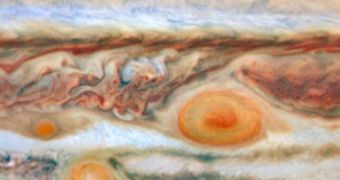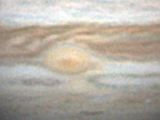As predicted when it was first discovered on May 9 this year, Jupiter's third red giant storm collided last week with the Great Red Spot and the Red Spot. The outcome of the event is not known yet, since Jupiter's position on the night sky impeded astronomers from carrying out any conclusive observations. "It's not really a spot any more. It's just sort of scrambled. It's a blob," said Glenn Orton of NASA's Jet Propulsion Laboratory.
Jupiter's Great Red Spot, which has been raging across its atmosphere for more than three centuries, was joined in 2006 by a similar hurricane-like white storm that suddenly changed its color to red. In May this year, the two were joined by yet another storm that turned from white to red. Scientists don't known exactly what processes determine these spots to change color to red, although it is most likely the result of material being lifted from deep within the atmosphere to the upper layers, where it reacts with sunlight and acquires a distinctive red color.
The third red spot was expected to collide this summer with the Great Red Spot, although astronomers were in for a big surprise, as the storm took a direction that led it right between the Great Red Spot and the Red Spot. "I didn't think it would get mashed between two of the largest storms in the solar system. That's not something anyone anticipated," added Orton.
As earlier said, the fate of the third red spot is currently unknown. It was either completely destroyed by the Great Red Spot or it has been partially torn apart, leaving remnants that may form in the future yet another spot. Regardless of the outcome, astronomers watching Jupiter in the following days may get an idea of the power of these storms, or reveal their extent in the atmosphere.
The Hubble Space Telescope was unable to make observations on Jupiter between June 29 and July 7, simply because the planet was not visible, but it is expected to relay several images in the next couple of days. Also, ground-based telescopes from all over the world have been taking a few pictures of the planet, but astronomers say that the outcome of the collision between the three giants will become more clear in about a week or so.

 14 DAY TRIAL //
14 DAY TRIAL // 
